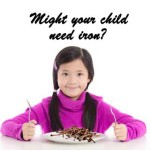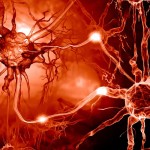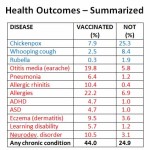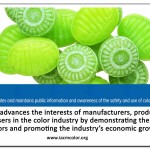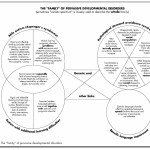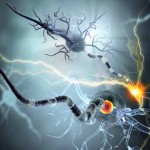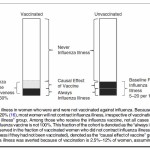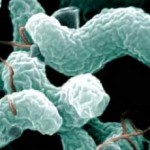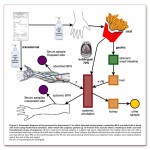This gallery contains 1 photo.
Nutritional Neuroscience, 2020 Sep 4:1-9 In a large group of children followed from birth, data on diet and behavior were obtained on 535 children at both 4 and 6 years old. The foodsinvestigated were divided into four basic groups: Sweet: … Continue reading →
This gallery contains 2 photos.
European Journal of Clinical Nutrition, November 2018; 72 (11):1517-1523. The authors studied several eating patterns among Chinese children. While the “processed,” “snack,” and “beverage” dietary patterns were all positively associated with ADHD symptoms, the “vegetarian” (more natural) dietary pattern was … Continue reading →
This gallery contains 2 photos.
Complementary Therapies in Medicine, 53 (2020) This paper is a meta-analysis of seven studies considering sugar consumption and ADHD. The authors concluded there is a “positive relationship between overall sugar and sugar-sweetened beverages consumption and symptoms of ADHD.” The authors … Continue reading →
This gallery contains 2 photos.
Advances in Neurobiology (2020) 24:481-504 While the research does not prove causation, there seems to clearly be a link between food dyes and symptoms of autism. Not only are there direct neurotoxic effects, but it has been shown that at … Continue reading →
This gallery contains 2 photos.
Frontiers in Psychiatry, August 2020, Volume 11, 730, pp. 1-12 An oligoantigenic diet is a few-foods diet, used sometimes to identify foods a child may be allergic to. It excludes all the food dyes, preservatives, and other additives, as well … Continue reading →
This gallery contains 1 photo.
Kirkland AE, Langan MT, & Holton KF, Nutritional Neuroscience (2020), DOI: 10.1080/1028415X.2020.1730614 Although this is a small pilot study, and the first to consider young adults, it indicates that food dyes may affect both brainwave activity and ADHD symptoms in … Continue reading →
Newsletter of the Feingold Association of the United States Read more … Want more? See the ARCHIVES beginning 1981 How can parents help their ADHD child? In the controversy over whether or not to use medication, some important issues are … Continue reading →
Newsletter of the Feingold Association of the United States Read more … Want more? See the ARCHIVES beginning 1981 How can parents help their ADHD child? In the controversy over whether or not to use medication, some important issues are … Continue reading →
This gallery contains 13 photos.
There has been a lot of controversy about the use of Hydroxychloroquine (HCQ) as a treatment of COVID-19. This is an old antiviral medication, in use for more than 60 years, and considered safe for daily use even during pregnancy, … Continue reading →
This gallery contains 3 photos.
(Updated February 14, 2023)If you have concerns about what is going on in the world of vaccines, you are not alone. I have long been collecting the research on all sides of this issue, and have begun organizing the studies … Continue reading →
This gallery contains 2 photos.
Milena Georgieva is a young scientist in Bulgaria with lots of prestigious awards for best scientific excellence practices. Here, she describes the way our DNA functions. The way we live, the way we talk, the way we breathe and the … Continue reading →
This gallery contains 1 photo.
Dr. Feingold comments on the FDA study The Kaiser-Permanente/University of California study funded by the FDA is commonly referred to as the FDA study. The study was supportive. One child out of 22 children under controlled conditions reacted unequivocally to … Continue reading →
The American Baby – A Victim of Corporate Profits? The American Council on Science and Health – the food industry’s new lobby – celebrates the International Year of the Child with a feature article in the August American Babymagazine; some … Continue reading →
Evening with Dr. Feingold Dr. Feingold was in the Washington area recently to participate in the Huxley Institute symposium. Board members of FAWA thank the doctor for giving us an evening of his time, and Rod & Trish Federick for … Continue reading →
Letter from Dr. Feingold to FAUS Members: Greetings; This past quarter has been quite eventful, not only for the concept of dietary management of behavioral disturbances and learning disabilities, but for the entire field of nutrition. So many events of … Continue reading →
NEW YORK (Associated Press) May 8, 1979 — There is no evidence that hyperactivity in children is caused by their diet, in particular by artificial food coloring, an independent association of scientists has found. The American Council on Science and … Continue reading →
This gallery contains 1 photo.
Letter from Dr. Feingold Greetings to all members of FAUS! It is almost six years since the AMA meeting in New York (June 1973), where I made the first public announcement linking food additives to behavioral disturbances and learning disabilities … Continue reading →
This gallery contains 1 photo.
Letter from Dr. Feingold Dear Parents: Some interesting and important events occurred during the past quarter. The FDA science symposium, “Effects of Foods and Drugs on the Development and Function of the Nervous System: Methods for Predicting Toxicity” was very … Continue reading →
This gallery contains 1 photo.
Letter from Dr. Feingold to the Feingold Association of the United States Greetings to All Members of FAUS, This past quarter has been very productive. Great progress has been made in public awareness, acceptance and application of the diet. This … Continue reading →
This gallery contains 2 photos.
The Nutrition Foundation Strikes Again We had not heard from the Nutrition Foundation for a long time. They’re the alter-ego of the American Council on Science and Health. Like ACSH, the Nutrition Foundation sounds like an unbiased, scientific pillar of … Continue reading →
This gallery contains 1 photo.
First FDA study supports Feingold theory Results from the first federally-sponsored study of the Feingold hypothesis are strongly supportive of a key facet of the KP diet. Following two experiments funded by the Food & Drug Administration, researchers at the … Continue reading →
This gallery contains 1 photo.
Dr. Feingold’s Visit Dr. Feingold addressed a standing-room-only audience of FAWA members on October 8th. Here are some of the highlights from his talk. We are no longer in the position of having to “prove” the validity of our knowledge. … Continue reading →
This gallery contains 1 photo.
Answering the critics FAWA Newsletter, December 1977 (page 9-10) Feingold families are often confronted by newspaper and magazine articles — some of which appear in medical journals — telling us that the KP Diet doesn’t really work. (Those sleepless nights … Continue reading →
This gallery contains 7 photos.
Feingold diet is worth testing, panel says American Medical News (newsletter of the American Medical Association)January 29, 1982, page 23.
This gallery contains 23 photos.
Does what we eat affect behavior? The St. Louis Globe-Democrat, August 3, 1977
This gallery contains 4 photos.
Just finished: a compilation of all the studies I can find on the food dyes used in the US and their connection with behavior and health. Download here(190 pages) This project was created to help the California Office of Environmental … Continue reading →
This gallery contains 1 photo.
Science. 207(4438): 1489-90. Red 3 was applied to nerve synapses in the frog, producing an irreversible, dose-dependent increase in neurotransmitter release. The author suggested this may be useful for studying neurotransmitters, but that the use of Red 3 as a … Continue reading →
This gallery contains 2 photos.
Toxicology Reports. 5: 146-155. This was not a test of tartrazine (Yellow 5) – they already knew it would be toxic. Rats in the “positive control” group (given Yellow 5) had elevated liver enzymes, cholesterol and triglycerides, as well as … Continue reading →
This gallery contains 23 photos.
If you, or your child, have a tic disorder or Tourette’s Syndrome, you may feel like the disorder controls your life. But there is hope — you can manage a tic disorder, naturally, so that you feel in control. Don’t … Continue reading →
This gallery contains 3 photos.
Journal of Child Healthcare. Mar;22(1):68-83 Ludlow and Rogers want to write a review of existing studies, but actually they are stuck with anecdotal reports because so little research has been done in this area. As they say, however, “anecdotal reports … Continue reading →
This gallery contains 2 photos.
Nutrients. May 10;10(5). pii: E591 Some of the many substances found in foods are neurotransmitters (NT), including acetylcholine, glutamate, GABA, dopamine, serotonin and histamine. Not only are these neurotransmitters part of the food itself, but they may be added or … Continue reading →
This gallery contains 2 photos.
Integrative Food, Nutrition and Metabolism, 2018, 5(4): 1-2 This editorial explores possible nutritional reasons for the huge difference between the United States and the United Kingdom in numbers of children diagnosed with ADHD or autism. After two separate studies in … Continue reading →
This gallery contains 2 photos.
Journal of AOAC International, Vol. 101. (epublished ahead of print) This guest editorial is not about the food dyes we know and don’t love — it’s about inedible, dangerous food dyes that are used illegally in foods. There is a … Continue reading →
This gallery contains 1 photo.
Scientific Reports, 2018 Jan 15;8(1):788. 17 studies on iron and ADHD were analyzed by Tseng et al in Taiwan. Iron does more than prevent anemia; besides helping in homeostatis of the hemoglobin (red blood cell) structure, iron is important to the … Continue reading →
This gallery contains 2 photos.
Nutrition. 2018 February. 46:36-40 This study found that 11.54% of the 1,681 processed items examined in a local supermarket in Singapore contained at least one of five food dyes — of which tartrazine (Yellow 5), sunset yellow (Yellow 6), and … Continue reading →
This gallery contains 2 photos.
Today I have finally listed all the “open” research studies collected up to now. This brings the Library Text Collection up to more than 3,000 papers listed. Now to start the next part of the project — updating the list … Continue reading →
This gallery contains 3 photos.
In study after study, the dangers of artificial food dyes are documented. Nevertheless, many of us would still like to provide colorful party foods for our families. What to do? Of course, bright fruits such as blueberries and strawberries can … Continue reading →
This gallery contains 1 photo.
Although this speech was given in 1978, it could equally apply today. Tragically, his warning went unheeded, and nothing has changed. Ladies and Gentlemen: I am pleased to be with you today to discuss the importance of the School Food … Continue reading →
This gallery contains 2 photos.
Contact Dermatitis. 2016 Oct;75(4): 258-9 This is a case report about a 45-year-old woman who began to dye her hair blue. After several years of rashes and itching on her scalp, face, and neck, she sought help from an allergist. … Continue reading →
This gallery contains 3 photos.
Journal of Translational Science, Volume 3(3): 1-12. doi: 10.15761/JTS.1000186 This is one of the first studies done to address the questions raised by the U.S. Institute of Medicine about the long term health outcomes of the vaccination schedule as used … Continue reading →
This gallery contains 2 photos.
SB 504 calls for state office to conduct independent review of evidence and options for the Legislature April 26, 2017 The Senate Health Committee today approved a bill by Senator Bob Wieckowski (D-Fremont) to direct a state agency to review … Continue reading →
This gallery contains 3 photos.
PeerJ. 2017 Feb 23;5: e3041. This study was done to evaluate the possible adverse effects of the color Tartrazine (Yellow 5) on kidney and liver function and structure in rats, as well as its affect on white blood cells. For … Continue reading →
This gallery contains 2 photos.
Food Additives & Contaminants, Part A, Chemistry, Analysis, Control, Exposure & Risk Assessment. 2017 March 23. Using complex statistics and a database of product labels, rather than direct measurements, an “estimate of daily intake” of the amounts of synthetic food … Continue reading →
PROLOGUE “What is the loss of job, career, professional license, honors, colleagues, and country against that of a child’s voice? How do the very public denigration of one’s science and the epithet of “child killer” from Bill Gates weigh against … Continue reading →
This gallery contains 1 photo.
Archives of Disease in Childhood. 2003 July; 88(7): 595-600. Newson here proposes that PDA should be considered a separate entity within the pervasive developmental disorders. Table 1 on Page 597 gives a detailed description of such a child, using 8 … Continue reading →
This gallery contains 2 photos.
Research in Developmental Disabilities. 2014 Dec; 35(12): 3236-44 Children with epilepsy often have other neurological problems such as autism and ADHD. This paper is a detailed report on four children with epilepsy as well as symptoms of PDA (Pathological Demand … Continue reading →
This gallery contains 1 photo.
Journal of Child Psychology and Psychiatry. 2014 July; 55(7):769-70 Beginning with a comment on “PDA” as sometimes used to mean “Public Display of Affection,” Gillberg says that in his own 40 years of clinical experience, PDA/EDA is not at all … Continue reading →
This gallery contains 1 photo.
Journal of Child Psychology and Psychiatry 55:7 (2014), pp 758–768 This paper is about the development and validation of the ‘Extreme Demand Avoidance Questionnaire’ (EDA-Q), to aid in diagnosis of PDA (Pathological Demand Avoidance) traits. PDA (or EDA) is a … Continue reading →
This gallery contains 1 photo.
European Child & Adolescent Psychiatry. 2016 April; 25(4): 407-19 The term “pathological demand avoidance” (PDA) describes children or adults within the autism spectrum who exhibit obsessive resistance to everyday demands and requests. In this study, the authors determined specific differences … Continue reading →
This gallery contains 2 photos.
Acta Histochemica. 2017 March; 119(2): 172-180 The authors used a rat model to answer the following questions: Does exposure to tartrazine (Yellow 5) influence the rats’ memory and learning? Does the tartrazine exposure have any effects on the volume of … Continue reading →
This gallery contains 2 photos.
American Journal of Epidemiology, 2016 Aug 1; 184(3):227-32 Giving pregnant women the flu shot is expected not only to prevent the flu in both mothers and newborns, but also to prevent adverse pregnancy outcomes such as preterm birth. According to … Continue reading →
This gallery contains 1 photo.
European Child & Adolescent Psychiatry. Sep;26(9): 1067-1079 In her review of the research, Dr. Ly discusses the use of elimination diets for ADHD and autism from the point of view of the interaction of the metabolic, immune, endocrine, and neural … Continue reading →
This gallery contains 1 photo.
Pediatrics, 2017 Jan 30. pii: e20162027 This study took place in Spain, where families have a long tradition of eating the Mediterranean diet. As diets today veer away from traditional healthful foods towards junk food, candies and convenience foods, behavior … Continue reading →
This gallery contains 3 photos.
This Gary Null Production is a long film – almost 2 hours – so get comfortable before you start. Although some parents are quoted in this film, most of the participants are medical doctors and researchers. ADDED Oct. 1, 2023: … Continue reading →
This gallery contains 2 photos.
Environmental Health, Feb 27;14:17. doi: 10.1186/s12940-015-0003-1. The authors comment that while environmental factors known to increase the risk of ADHD include exposure to manganese, poly-chlorinated biphenyls (PCBs), nicotine, mercury, arsenic, food additives, food coloring, pesticides and lead, almost no attention … Continue reading →
This gallery contains 3 photos.
PLoS One. 2014 Oct 22;9(10): e110509. If you must handle thermal receipts, don’t use sanitizers or hand lotion – both often contain chemicals that will encourage the BPA to slide right through your skin. In the experiment described in this … Continue reading →
This gallery contains 2 photos.
Child Care Health & Development. 2015 May;41 (3):424-33 This study examines the “mechanisms by which food advertising prompts children’s consumer behavior.” The children respond to advertising by (1) an increase in expectations and purchase motivation, (2) happiness upon acquiring the … Continue reading →
There are many preservatives – some quite natural and others … not. The three most commonly used preservatives in the United States are BHT, BHA, and TBHQ. They are petrochemicals (made from petroleum), and not allowed in some countries. Although … Continue reading →
This gallery contains 2 photos.
The Journal of Clinical Psychiatry. 2016 Oct;77(10): e1342-e1347 Drugs used for bipolar disorder often work by down-regulating the brain metabolism of a long-chain omega-6 (or n-6) essential fatty acid called arichidonic acid (AA). The shorter-chain omega-6 (or n-6) essential fatty … Continue reading →
It’s hard to understand why something as innocent as a piece of fruit or a bag of candy can result in sleep problems, some of which can be extreme. Most people can enjoy healthy food like fruits with no harmful … Continue reading →




























